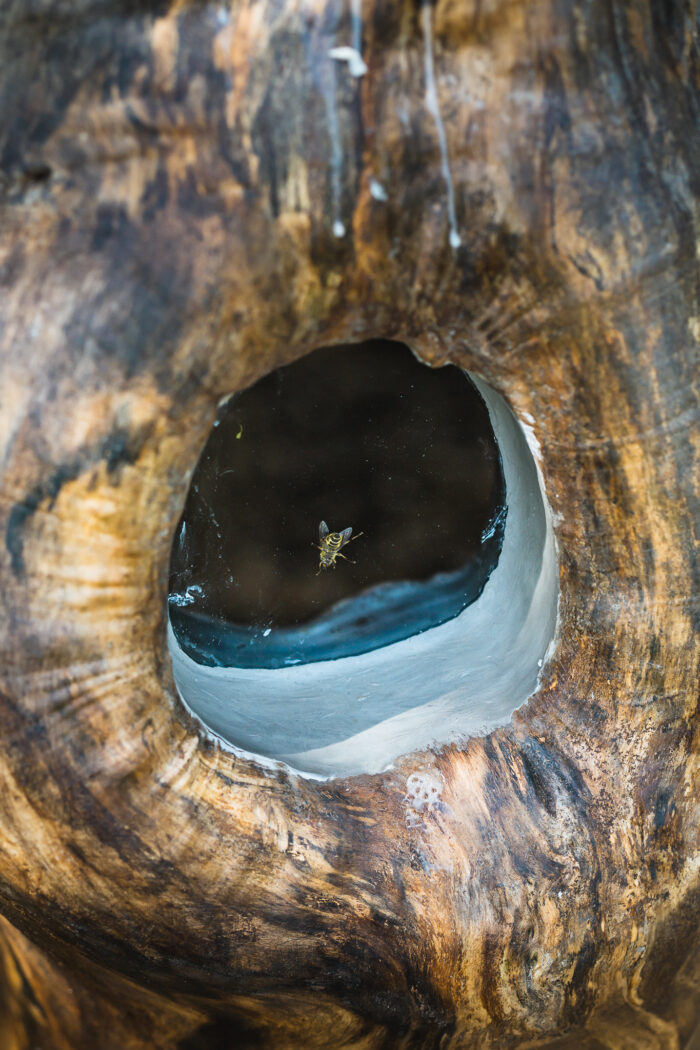Bee conservation: About the new handcrafted log beehive
Bee conservation: About the new handcrafted log beehive
And how it was built
The hum of bees is the voice of the garden.
-Elizabeth Lawrence

For the last month, the Estates team have been working fervently to handcraft a new Log Beehive with the purpose being to attract honey bees to Combe Grove and encourage the pollination of the Kitchen Garden.? Bees are an essential part of our ecosystem; they are vital for pollinating both foods for us to eat, and plants and trees for other wildlife to survive. Simply put, bees keep our much-loved plants and crops alive. Since they spend a lot of time here, we felt that it was important for us to create a safe space for the bees at Combe Grove.
How the handcrafted log beehive was built –
The log that has been used to create the hive was donated by a local tree surgeon; a natural sycamore hollowed tree trunk. The base and top were then added by members of the estate’s team. The base is made from sycamore and the top from cedar. Hardwoods are the ideal components for a log hive for longevity.
The infrastructure of the hive has been glued together using natural non-paraffin wax, which is not beeswax or soy wax* and the main hole in the log has a glass front window as a viewing platform. As bees begin building from the top downwards, a small entrance positioned at the bottom of the log is essential.

*The environmental effects of soy wax: Much of the time, soy is not grown sustainably. Most soy is grown in South America, where it has an effect on deforestation and is a threat to biodiversity. It is of high importance for us to use materials that have been ethically and locally grown.
Where it is situated –
The log hive is south facing to ensure that it is situated in the perfect position to catch the warm sun and is situated in the kitchen garden to aid the pollination of the crops. However, any honey made by the wild bees will remain for the bees and none will be taken for human consumption.
Why log hives are a great home for Bees
- Temperature: the hives are naturally insulated so that they are the correct temperature for the bees.
- Minimal intervention: The bee log hive only has a small entrance for the bees to come and go, which means minimal to no intervention from us.
- Off the ground: Having the hive off the ground helps to ensure that the bees are safer from predators and eliminates some of the risk of dampness.
Why the log hive is so important
Our philosophy for beekeeping is to replicate the natural habitat that bees would have in the wild. When in the wild, bees would usually live in hollowed out trees. Log hives help to replicate these circumstances, buffering the temperatures of the different seasons. Our log hives are here to promote healthier and happier bees.
In commercial beekeeping, honey production can be created from upwards of 100 of hives in a very small proximity. This way of beekeeping is detrimental to the landscape and solitary and native bees. Bees do not have enough landscape to share and end up harming each other in their efforts to collect pollen. To practice more sustainable and API-centric beekeeping (To prioritise the bees, rather than the human benefit), there should only be a limited number of colonies within a small proximity.
Here is an interesting article on Api-centric beekeeping.
Why is the temperature of a beehive so important?
Sadly hives that are more artificial are prone to pests and diseases such as varroa mites, due to the poor construction and materials. In these types of hives, the temperature is not as maintained as it would be in a more insulated tree or log hive. If the temperature is not maintained naturally then the bees need to use their own energy to preserve the correct temperature which leaves them more susceptible to diseases.
There has been a huge decline for pollinators over recent years and it is one of our top priorities to create the best possible habitat for bees to survive in a way that is not human-centric.
All steps taken at Combe Grove are done with the consideration of the planet and the conservation of the other living creatures around us. We hold weekly wildlife watching evenings to give you the opportunity to see the hidden wildlife living in the Estate and experience an educational talk, led by our Team Leader and master in his field, Steve Hill. If you missed the last badger watching emails, send an email to hello@combegrove.com to be put on the waiting list, or head into the Caff to book your place.

We also invite you to take part in restoring the estate and learn new skills in a controlled, safe and healthy environment by joining our volunteering team. If this interests you, then learn more about the volunteering club here or drop an email to thevolunteeringclub@combegrove.com. If you would like to learn more about our work with the land at Combe Grove, please feel free to get in contact or come and visit.